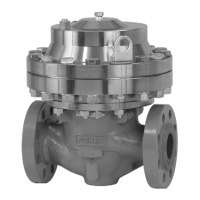20
14. Lightly lubricate the O-rings (keys 15 and 17) and the
inner and outer diaphragm (key 20) edges. Place the
inlet plate (key 18) and the diaphragm (key 20) on the
sleeve (key 14). Make sure O-rings (key 15 and 17)
are correctly positioned. Insert and tighten the hex
socket cap screws (key 16). See Torque Specication
table for proper torque.
15. Carefully lift the lower actuator casing assembly
(key 5) and place on the body (key 1). Take care
to match up the alignment marks. Secure with
screws (key 24). See Torque Specication table for
proper torque.
16. Lightly lubricate the spring (key 13) and place on the
inlet plate (key 18).
17. Carefully place the upper actuator casing (key 11)
on the lower actuator casing (key 5). Take care
to match up the alignment marks. Insert the two
threaded stems 180° apart and away from anges.
Place the washers and hex nuts (keys 22 and 23)
and brackets on the long cap screws and evenly
tighten. Install remaining small cap screws (key 21),
washers and hex nuts. Replace the two threaded
stems by two bolts (keys 21, 22 and 23). See Torque
Specication table for proper torque.
18. Place the travel indicator assembly (keys, 138, 139,
140, 141, 142, 143, 144, 145 and 192) in the upper
actuator casing (key 11) by hitting the tip of the
stem (key 139) to clip the tting (key 144) into the
plate (key 18) and tighten the travel indicator tting
(key 141).
Type EZHSO Actuator Maintenance
1. Make a mark on the upper actuator casing (key 11),
lower actuator casing (key 5), intermediate
ange (key 25) and body (key 1) to indicate
proper alignment.
2. Remove travel indicator assembly (keys 138, 139,
140, 141, 142, 143, 144, 145 and 192), if present,
by loosening the travel indicator tting (key 141) and
lifting out the travel indicator assembly.
3. Remove protective cap (key 146). Loosen and
remove hex nuts (key 151).
4. Remove cap screws (key 21), washers (key 22) and
hex nuts (key 23). Remove protective cap (key 146)
and remove hex nuts (key 151). Carefully lift the
upper actuator casing (key 11) off the lower actuator
casing (key 5).
5. Remove the socket head cap screws (key 16).
Lift off the diaphragm (key 20) and the inlet plate
(key 18). Remove O-rings (keys 15 and 17). Inspect
the diaphragm and O-rings for damage or wear and
replace if necessary.
6. Inspect the upper actuator casing (key 11), O-ring
(key 9), anti-friction split rings (key 8) and anti-friction
ring (key 4) for damage or wear. If damaged, remove
the O-ring and split rings and replace with new parts.
Lightly lubricate the O-ring and split rings. Place
the split rings in the body rst, then slide the O-ring
between the split rings.
7. Remove screws (key 24). Lift off the lower actuator
casing (key 5). Remove the hex socket cap screw
(key 154). Lift off the disk holder assembly (key 30).
8. Slide the sleeve (key 14) out of the lower actuator
casing (key 5) and slide the outlet plate (key 19) off of
the sleeve. Check the sleeve for scratches, burrs or
other damage and replace if necessary.
9. Inspect the lower actuator casing (key 5), O-ring
(key 9), anti-friction split rings (key 8) and anti-friction
ring (key 4) for damage or wear. If damaged, remove
the O-ring and split rings and replace with new parts.
Lightly lubricate the O-ring and split rings. Place
the split rings in the body rst, then slide the O-ring
between the split rings.
10. Slide the outlet plate (key 19) onto the sleeve
(key 14) and slide the sleeve into the lower actuator
casing (key 5). Place the disk holder assembly
(key 30) on the sleeve adaptor (key 27). Insert the
hex socket cap screw (key 154) and tighten. See
Torque Specication able for proper torque.
11. Lightly lubricate the O-rings (keys 15 and 17) and the
inner and outer diaphragm (key 20) edges. Place the
inlet plate (key 18) and the diaphragm (key 20) on the
sleeve (key 14). Make sure O-rings (keys 15 and 17)
are correctly positioned. Insert and tighten the hex
socket cap screws (key 16). See Torque Specication
table for proper torque.
12. Carefully lift the lower actuator casing assembly
(key 5) and place on the body (key 1). Make sure
to match up the alignment marks. Secure with
screws (key 24). See Torque Specication table for
proper torque.
13. Carefully place the upper actuator casing (key 11)
on the lower actuator casing (key 5). Make sure to
match up the alignment marks. Insert the two long
bolts 180° apart and away from anges. Place the
washers (key 22), hex nuts (key 23) and brackets
(key 35) on the long bolts and evenly tighten. Using
proper bolting techniques, install remaining short cap
screws (key 21), washers and hex nuts. See Torque
Specication table for proper torque.
14. Tighten hex nuts (key 151), install protective cap
(key 146).
15. Place travel indicator assembly (keys 138, 139,
140, 141, 142, 143, 144, 145 and 192) in the upper
actuator casing (key 11), if present and tighten the
travel indicator tting (key 141).

